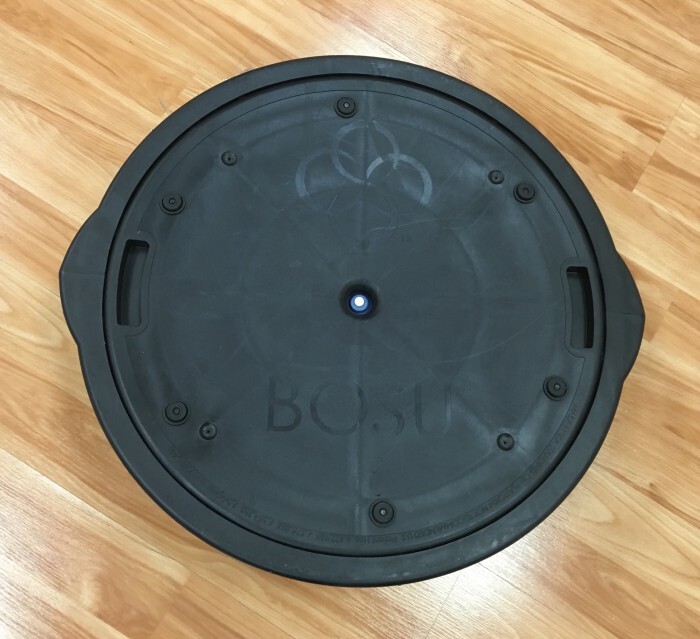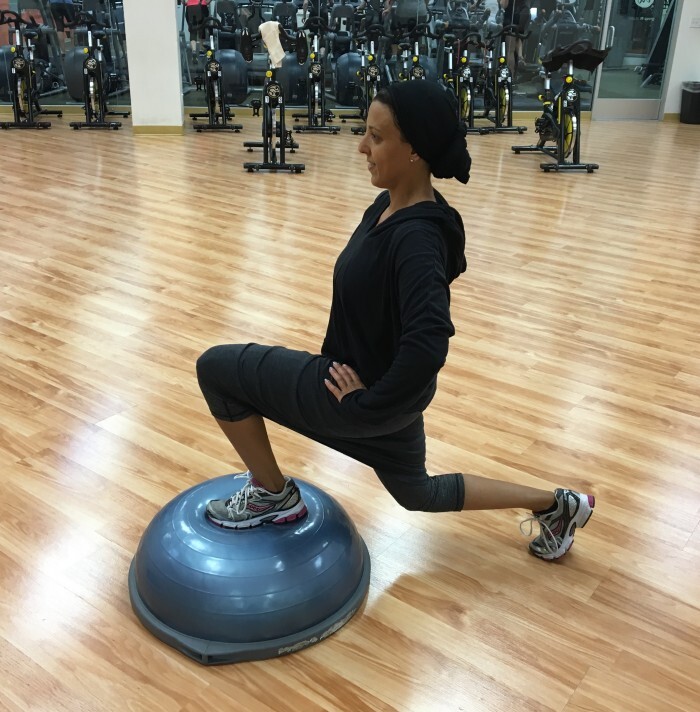
How’s your balance? You might feel pretty confident, until you step onto the BOSU and try your standard strength moves on an uneven surface. Read on to find out how our blogger fared in a BOSU strength class, and how this device can challenge balance, strength, and coordination.

A century ago, the medicine ball was all the rage, lifted by men in straw boaters in striped tank tops, sporting handlebar mustaches. Fast forward in the fitness time machine past kettle and stability balls and into the gyms of today, and you’ll find the belle of the fitness ball is now the BOSU. If you take a giant stability ball and cut it in half, adding a plastic platform to one side, you get the wildly popular BOSU Balance Trainer.
Invented in 1999 by David Weck, the name BOSU came from an acronym for “BOth Sides Utilized.” And in fact, this is a device that allows you to train on both sides of it. When the ball part is up, the surface is unstable, but the support platform is very stable. However, when you flip it over, the device becomes even more unstable because the platform is resting on a curved dome.

To experience this apparatus first hand, I headed to the Total Woman Gym in Studio City, CA to take a BOSU strength class, and I immediately saw why the BOSU Balance Trainer is a fitness favorite. The idea of stepping up on half of an inflated ball and then on a platform balanced on half a ball was extremely daunting, but my teacher Naomi Cohen made it seem like the most natural and fun thing in the world. A pint-sized powerhouse, Naomi was the perfect balance of tough trainer and soothing sensei. She encouraged us to be safe but push ourselves to work as hard as we could physically and mentally. We started with the dome side up and did aerobic moves that are often associated with step aerobics, but instead of using a step, we used the BOSU. Then we moved on to squats while balancing on the half ball and lunges with one foot anchored on the ball. We did planks using the ball for leg support.
Next, we flipped the BOSU so the platform was on top, grabbed our hand weights, and climbed aboard. It was like exercising on a surfboard in the ocean. You perform basic arm, core, and back exercises with dumbells while trying to stay balanced on the platform. At one point, we moved our feet to the edges of the platform and alternated bending our knees with our feet parallel. The move resembled mime walking, but off the ground. Naomi had us move our feet closer together on the platform, engage our cores and close our eyes if possible, so we could fully experience the balance challenge for our individual bodies. Then, we flipped the BOSU again, and used it to prop up our back for more core work, including sit-ups into a standing position for the advanced. Finally, Naomi cooled us down and reminded us about the importance of stretching after this workout to relieve soreness and protect the muscles and joints.

As a person with knee and hip issues, the balance aspect was really challenging, but therapeutic, because it forced me to use my core and the stabilizing muscle groups in my legs to support my body weight. BOSU training is stellar for all ages, and many physical therapists recommend it as people age, because the exercises improve balance and strengthen core, legs and ankles, which can help prevent falls.
Although BOSU classes are extremely popular in LA and in gyms all over the world, you can also purchase the apparatus and a variety of great videos to lead you through a BOSU based workout at home. In addition to the great cardio and toning that BOSU training provides, there is a real freedom and fun in the surfing sensation you get when you finally master your fear and achieve your BOSU balance.
***
Want more unique fitness ideas? Check out our piece on Rucking and our profile on Sandbox Fitness.


